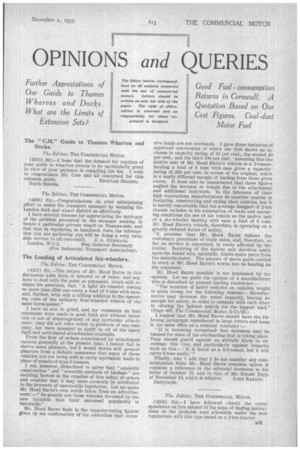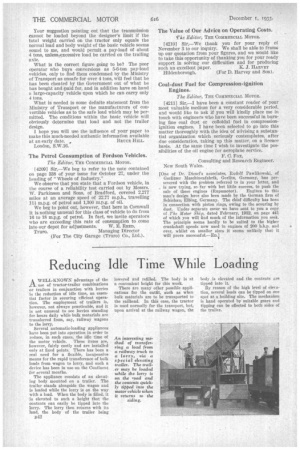OPINIONS and QUERIES The " C.M." Guide to Thames Wharves and Docks.
Page 59

Page 60

If you've noticed an error in this article please click here to report it so we can fix it.
The Editor, THE COMMERCIAL MOTOR.
[4205] .Sir,—I hope that the demand for reprints of your guide to wharves proves to be particularly great in view of your patience in compiling the list. I wish to congratulate Mr. Cole and all concerned for this
valuable guide. REGULAR READER. North Shields.
The Editor, THE COMMERCIAL MOTOR.
(42061 Sir,—Congratulations on your enterprising effort to assist the transport manager by mapping the London dock and wharf district so effectively.
I have several reasons for appreciating the intricacy of the problem presented to the stranger seeking to locate a particular private wharf on Thames-side, and feel that in reprinting in handbook form the information you are gathering you will be doing a very valu able service to all concerneb. J. A. DUNNAGE,
London, W.C.2. Hon. General Secretary (For Industrial Transport Association).
The Loading of Articulated Six-wheelers.
T he Editor, THE COMMERCIAL MOTOR.
[4207] Sir,—The return of Mr. Hood Barrs to this discussion adds little of interest or of value, and neglects to deal with the point at argument, which still remains his assertion, that "A light six-wheeler costing no more than £300 can carry a load of 6 tons with ease, and, further, with only a trifling addition to the operating costs of the ordinary four-wheeled vehicle of the same horse-power."
I have no axe to grind, and my comments on that statement were made in good faith and without intention or act of disparagement of any particular attachment; they did not refer solely to products of one company, but were intended to apply to all of the many rigid and articulated attachments available.
From the flow of orders experienced by attachment makers generally at the present time, I cannot fail to derive some pleasure, but I would derive still greater pleasure from a definite assurance that many of these vehicles are not being sold to carry equivalent loads in place of standard-type 6-tonners.
I am, however, disinclined to agree that "scientific construction" and "scientific methods of haulage" are deciding factors in the creation of this influx of orders and consider that it may more correctly be attributed to the pressure of unscientific legislation. Let me quote Mr. Hood Barrs's own words taken from an advertisement :—" So greatly are these vehicles favoured by the new taxation that their universal popularity is inevitable."
Mr. Hood Barrs finds in the capacity-rating figures given by me confirmation of his contention that exces sive loads are not overloads. I gave three instances of approved conversions of which the first shows an increase in capacity rating of 50 per cent., the second 40 per cent., and the third 100 per cent. Assuming that the motive unit of Mr. Hood Barrs's vehicle is a 2-tormer, hauling a load of 6 tons with ease gives a capacity. rating of 200 per cent. in excess of the original, which Is a vastly different margin of loading from those given above. It must also be remembered that these figures neglect the increase in weight due to the attachment and additional bodywork. In the interests of their high reputations, manufacturers do exercise caution in designing, constructing and rating their vehicles, but it is hardly conceivable that the average designer of 2-ton chassis includes in his assumption of loads and operating conditions the use of his vehicle as the motive unit of a six-wheeler hauling with ease a load of 6 tons. Mr. Hood Barrs's vehicle, therefore, is operating on a greatly reduced factor of safety.
presume 'that Mr. Hood Barrs follows the customary procedure of trade sales, and, therefore, so far as service is concerned, is solely affected by the trailer. Servicing of the motive unit devolves solely upon the dealer who, naturally, draws spare parts from the manufacturer. The amount of spare parts carried in stock at Mr. Hood Barrs's works has no bearing on the argument.
Mr. Hood Barrs possibly is not impressed by my opinion. Let me quote the opinion of a manufacturer who is disturbed by present loading tendencies :— " The taxation of motor vehicles on unladen weight is quite wrong for the following reasons :—Manufacturers may increase the rated capacity, leaving no margin for safety, in order to compete with each other in offering the lightest vehicle for the biggest load." (Page 407, The Commercial Motor, 3/11/33.)
I suggest that Mr. Hood Barrs should have the following paragraph reproduced in large letters and hung Jr. his sales office as a constant reminder :— "1t is becoming recognized that salesmen may be blamed for some of the overloading that is taking place. They should guard against an attitude likely to encourage this vice, and particularly against remarks such as this It is listedas a 3-4-tonner, but it will carry 6 tons easily,'" Finally, may I add that I do not consider any communication from Mr. Hood Barrs complete unless it contains a reference to the editorial footnotes to his letter of October 27, and to that of Mr. Ernest Tapp
of November 10, which is relative, SOHN RANKIN. Dalrymple.
The Editor, THE COMMERCIAL MOTOR.
[4208] Sir,—I have followed closely the correspondence on this subject in the hope of finding instructions on the probable load allowable under the new regulations with this type based on a 2-ton tractor. Your suggestion pointing out that the transmission cannot be loaded beyond the designer's limit if the total weight carried on the tractor only equals the normal load and body weight of the basic vehicle seems sound to me, and would permit .a pay-load of about 4 tons, unlesslexcessive load be carried on the trailing axle.
What is the correct figure going to be? The poor operator who buys conversions as 5-6-ton pay-load vehicles, only to find them condemned by the Ministry of Transport as unsafe for over 4 tons, will feel that lie has been cheated by the Government out of what lie has bought and:paid for, and in addition have on hand a large-capacity vehicle upon which he can carry only 4 tons.
What is needed is some definite statement from the Ministry of Transport or the manufacturers of convertible vehicles as to the safe load which may be permitted. The conditions within the basic vehicle will obviously determine that load and not the trailer design.
I hope you will use the influence of your paper to make this much-needed authentic information available
at an early date. • BRUCE HILL. London, S.W.16.
The Petrol Consumption of Fordson Vehicles. The Editor, THE COMMERCIAL MOTOR.
14209] Sir,—We beg to refer to the note contained on page 338 of your issue for October 27, under the heading of " Wheels of Industry."
We observe that you state that a Fordson vehicle, in the course of a reliability test carried out by Messrs. W. Parkinson and Sons, of Bradford, covered 2,277 miles at an average speed of 22.77 m.p.h., travelling 11i m.p.g. of petrol and 1,300 m.p.g. of oil.
We beg to point out, however, that here in Cornwall it is nothing unusual for this class of vehicle to do from 16 to 18 m.p.g. of petrol. In fact, we invite operators who are exCeeding this rate of consumption to come into our depot for adjustments. W. E. REED, Truro. Managing Director (For The City Garage (Truro) Co., Ltd.).
The Value of Our Advice on Operating Costs. 'rice Editor, THE COMMERCIAL MOTOR.
[4210] Sir,—We thank you for your reply of November 3 to our inquiry. We shall be able to frame up our quotation from your figures, and we would like to take this opportunity of thanking you for your ready support in solving our difficulties and for producing such an excellent paper. K. J. HARVEY Hildenborongh. (For D. Harvey and Son).
Coal-dust Fuel for Compression-ignition Engines.
The Editor, THE COMMERCIAL MOTOR.
[4211] Sir,—I have been a constant reader of your most valuable medium for a very considerable period, and would like to ask if you will kindly place me in touch with engineers who have been successful in burning fine coal dust or colloidal fuel in compressionignition engines. I have been selected to go into this matter thoroughly with the idea of advising a substantial organization which seriously contemplates, after due consideration, taking up this matter, on a licence basis. At the same time I wish to investigate the possibilities of the oil engine for aeroplane service.
F. C. Fox, [One of Dr. Diesel's associates, Rudolf Pawlikowski, of . Gorlitzer Maschinenfabrik, Gorlitz, Germany, has persevered with the problem referred to in your letter, and is now trying, so far with but little success, to push the sale of these engines (Rnpamotor). Engines to this man's design have also been made by the German firm of Schichan, Elbing, Germany. The chief difficulty has been in connection with piston rings, owing to the scouring by dust. Under separate cover we have sent to you a copy of . The Motor Ship, dated February, 1932, on page 441 of which you will find much of the information you seek. The principle seems hardly to be suited to the higher crankshaft speeds now used in engines of 200 b.b.p. and • over, whilst on smaller sizes it seems unlikely that it will prove successful.—ED.1




































































































